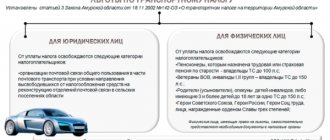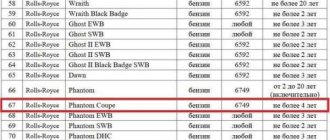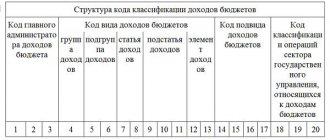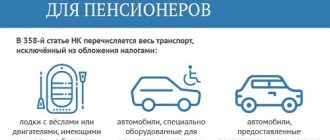As is clear from the name of the tax, its payers are vehicle owners. What formula to use to calculate and within what time frame to transfer the transport tax - you will find this information in the article.
Transport tax is paid by transport owners. The tax is regional, that is, the transport tax rate depends on the decision of regional authorities.
All the nuances regarding transport tax for legal entities are in Chapter. 28 Tax Code of the Russian Federation.
Most often, tax is calculated on cars and buses that are on the company’s balance sheet. However, for specific activities, tax is also paid from other types of transport. For example, a yacht club that rents boats, launches or yachts will pay tax on this water transport. But it should be borne in mind that not all types of transport are subject to taxation. Their list can be found in Art. 358 Tax Code of the Russian Federation.
From 2021, organizations will themselves report to the tax office what taxable vehicles they have. This is necessary if the inspectors did not indicate all vehicles in the tax payment message or did not send the message at all. The 2021 submission deadline is December 31, 2021.
If such a message is not sent, you will be charged a fine of 20% of the unpaid tax.
Features of payment of transport tax by legal entities
1Who calculates transport tax for organizations according to the tax code in 2021?
Taxpayers are organizations, as opposed to individuals. persons calculate the amount of transport tax independently. The results of the calculations are provided at the end of the tax period in the declaration.
Taxpaying organizations calculate the amount of tax and the amount of advance tax payment independently.
clause 1 art. 362 Tax Code of the Russian Federation
At the end of the tax period, taxpayers-organizations submit a tax return to the tax authority at the location of the vehicles.
clause 1 art. 363.1 Tax Code of the Russian Federation
2Are organizations required to make advance payments?
Companies make advance payments throughout the year. However, constituent entities of the Russian Federation have the right to establish their own rules for paying auto tax, including exempting organizations from advances. In this case, TN is paid once a year.
During the tax period, taxpayers-organizations pay advance tax payments, unless otherwise provided by the laws of the constituent entities of the Russian Federation.
clause 2 art. 363 Tax Code of the Russian Federation
3What changes have occurred in the transport tax for legal entities in 2021?
Organizations are required to use a new declaration form for reports for 2021. The 2021 form differs in that several new lines have been added to section 2 of the document.
Order of the Federal Tax Service of Russia dated December 5, 2016 N ММВ-7-21/ [email protected]
4Do I need to submit a tax return declaration if the organization does not own vehicles?
Taxpayer declarations are prepared only by taxpaying organizations. If legal the person is not a taxpayer, that is, if the company does not have cars registered or cars that are not taxed (for example, agricultural machinery) are registered, then there is no need to submit a declaration.
The Code... does not provide for the obligation to submit to the tax authorities tax returns (tax calculations for advance payments) for the transport tax of organizations that are not recognized as taxpayers of this tax, including organizations that have registered vehicles in accordance with the established procedure that are not in accordance with paragraph 2 Article 358 of the Code is an object of taxation.
Federal Tax Service of the Russian Federation dated 04/03/2008 N ШС-6-3/ [email protected]
5What is the formula for calculating car tax for legal entities? persons?
TN = (Tax base) x (Tax rate) x (Kp coefficient) x (Kv coefficient).
The tax base is nothing more than the horsepower of the car. That is, for a car with an engine power of 75 hp. tax base = 75. The exact amount of horsepower is indicated in the documents for the car - in the PTS and STS. We will consider the remaining components of the formula separately.
History of transport tax in Russia
The history of transport tax in Russia dates back to the 20s of the 20th century. Almost 100 years ago, vehicles were horses, horse-drawn carriages, bicycles, etc. However, in the resolution of the All-Russian Central Executive Committee “On the volost budget” of 1924, there is already a clause “Tax on vehicles” in the section “Income sources”. Since then, the transport tax has undergone many changes, and the list of objects of taxation has become wider.
By 1981, technological advances had led to the exclusion of cyclists, horse owners and other riding animals from the tax bracket. Starting this year, the amount of transport tax began to be affected only by the power of the car. In 1991, for the first time, transport tax rates were differentiated depending on their capacity.
After another 10 years, the Federal Road Fund of the Russian Federation was abolished. The new federal law on tax rates brought them closer to the values that look familiar today. This meant one thing - a sharp increase in tax rates, while regional authorities could increase or decrease them. Previously, before this reform, all contributions from drivers went to special road funds. And then all the fees were spent on maintaining the roads in good condition. Now the entire transport tax goes to the regional budget and is distributed by it for various needs at its own discretion.
In 2013, the Federal Law “On Amendments to Article 362 of Part Two of the Tax Code of the Russian Federation” was adopted. He supplemented the rules for calculating transport tax by introducing increasing coefficients for expensive cars. Since then, there have been no significant changes. We have described only briefly how long the transport tax has existed in Russia and how many changes the procedure for its calculation has undergone. At the same time, many car enthusiasts sincerely do not understand what and why they pay. After all, even if the car has been sitting in the garage for years, but it has more power, you have to pay more tax than if the roads are intensively used by less powerful cars. In addition, as we wrote above, the very purpose of collecting transport tax has become very vague. Over the past few years, rumors have regularly appeared and all sorts of discussions have arisen about the “cancellation” of the transport tax, or rather replacing it with either an environmental tax, or its inclusion in the price of gasoline, etc. However, the Russian government opposed these initiatives, since this would lead to a loss of budget revenues of the constituent entities of the Russian Federation. And when something will change is unknown.
Transport tax rate for legal entities
The tax rate is one of the main parameters for calculating road tax. Tax for legal entities persons and individuals persons is calculated at the same rates. This means that the amount of car tax for organizations and citizens will not differ.
The rates vary by region, since according to the Tax Code, constituent entities of the Russian Federation have the right to independently set them depending on:
- Type of vehicle (car/truck, bus, motorcycle, etc.);
- Engine power in horsepower;
- Year of release;
- Ecological class.
You can view transport tax rates for legal entities by region for 2021 using this table.
| Select your region | ||
| 77, 99, 97, 177, 199, 197, 777 Moscow | 78, 98, 178 St. Petersburg | |
| 01Republic of Adygea | 30Astrakhan region | 57 Oryol region |
| 02, 102 Republic of Bashkortostan | 31Belgorod region | 58Penza region |
| 03Republic of Buryatia | 32Bryansk region | 59, 81, 159 Perm region |
| 04Altai Republic | 33Vladimir region | 60Pskov region |
| 05Republic of Dagestan | 34, 134 Volgograd region | 61, 161 Rostov region |
| 06Republic of Ingushetia | 35Vologda region | 62Ryazan region |
| 07Kabardino-Balkaria | 36, 136 Voronezh region | 63, 163 Samara region |
| 08Republic of Kalmykia | 37Ivanovo region | 64, 164 Saratov region |
| 09Karachay-Cherkessia | 38, 85, 138 Irkutsk region | 65Sakhalin region |
| 10Republic of Karelia | 39, 91 Kaliningrad region | 66, 96, 196 Sverdlovsk region |
| 11Komi Republic | 40Kaluga region | 67Smolensk region |
| 12Republic of Mari El | 41, 82 Kamchatka region | 68Tambov region |
| 13, 113 Republic of Mordovia | 42, 142 Kemerovo region | 69Tver region |
| 14Republic of Sakha (Yakutia) | 43Kirov region | 70Tomsk region |
| 15Republic of North Ossetia | 44Kostroma region | 71Tula region |
| 16, 116 Republic of Tatarstan | 45Kurgan region | 72Tyumen region |
| 17Republic of Tyva | 46Kursk region | 73, 173 Ulyanovsk region |
| 19Republic of Khakassia | 47Leningrad region | 74, 174 Chelyabinsk region |
| 21, 121 Chuvash Republic | 48Lipetsk region | 75, 80 Transbaikal region |
| 22Altai region | 49Magadan region | 76Yaroslavl region |
| 23, 93, 123 Krasnodar region | 50, 90, 150, 190, 750 Moscow region | 79Jewish Autonomous Region |
| 24, 84, 88, 124Krasnoyarsk region | 51Murmansk region | 83Nenets Autonomous District |
| 25, 125 Primorsky Krai | 52, 152 Nizhny Novgorod region | 86, 186 Khanty-Mansi Autonomous Okrug |
| 26, 126Stavropol region | 53Novgorod region | 87Chukotka Autonomous Okrug |
| 27Khabarovsk region | 54, 154 Novosibirsk region | 89Yamalo-Nenets Autonomous Okrug |
| 28Amur region | 55Omsk region | 95Chechen Republic |
| 29Arkhangelsk region | 56Orenburg region | |
Please note: Those regions of Russia in which there is no transport tax law use the general rates specified in Art. 361 Tax Code of the Russian Federation.
The tax base
The tax base is:
- engine power in horsepower - for vehicles with engines (except for air vehicles with jet engines);
- gross tonnage in registered tons - for non-self-propelled (towed) water vehicles;
- nameplate statistical thrust of a jet engine in kilograms of force - for aircraft with a jet engine;
- vehicle unit – for other water and air vehicles.
Determine the tax base separately for each vehicle.
Such rules are established by Article 359 of the Tax Code of the Russian Federation.
Transport tax coefficient for legal entities
The coefficient KP (increasing coefficient) is used to calculate the tax on passenger cars whose cost exceeds 3 million rubles. The list of such cars is updated every year; it can be found on the website of the Ministry of Industry and Trade.
The luxury coefficient applies not only to organizations, but also to car owners-citizens. It depends on the average cost and year of manufacture of the car.
The sizes of the coefficients according to clause 2 of Art. 362 of the Tax Code of the Russian Federation, see the table:
| Car cost | How many years have passed since the year of manufacture | Increasing factor |
| 3 - 5 million rubles. | 2 - 3 years | 1,1 |
| 3 - 5 million rubles. | 1 - 2 years | 1,3 |
| 3 - 5 million rubles. | less than 1 year | 1,5 |
| 5 - 10 million rubles. | less than 5 years | 2 |
| more than 15 million rubles. | less than 20 years | 3 |
Transport tax coefficient for legal entities
The Kv coefficient (the number of months of vehicle ownership per year) is used if the car was not registered to the company for the entire tax period, that is, not a full year. For example, if a company registered a car or deregistered it in the middle of the year.
The coefficient is calculated using the following formula:
- Kv = (Number of full months of vehicle ownership) /12.
How to correctly calculate the number of months when registering a new vehicle on a legal basis. face:
- If the vehicle was registered on the 15th or earlier, the month is taken into account;
- If the 16th or later is not taken into account.
How to correctly calculate the number of months when deregistering a vehicle:
- If the vehicle was deregistered on the 16th or later, the month is taken into account;
- If the 15th or earlier is not taken into account.
For example, the coefficient Kv when registering a car on May 16 will be equal to 7/12. When deregistering a car on the same date, Kv = 5/12.
When moving a vehicle within an organization, the Q factor should also be used. Let's say a company registered a car with the traffic police on April 15, and later decided to transfer it to a department in another city. The registration date for the unit is November 18. How to correctly calculate Kv in this case:
1We count how many full months the parent organization used the car.
2We count how many full months the unit used the car.
From November 18 until the end of the year, 1 month will pass. That is, unit Kv = 1/12.
Are reduction factors used?
In addition to increasing the amount of transport tax, reducing coefficients also participate in the calculation. First of all, these are benefits that apply to certain types of transport and certain groups of payers (pensioners, veterans, disabled people). This may be a full exemption or a partial reduction expressed as a percentage. Reducing factors apply to vehicles that changed ownership in the reporting year, for example, were purchased, sold or stolen in any month. In this case, the reduction is calculated as the ratio of the number of months of ownership to 12.
Calculator for calculating transport tax for legal entities
You can calculate transport tax for legal entities in 2021 using an online calculator. It works according to the same calculation formula, but does not yet take into account the Kp coefficient. Therefore, to calculate the final cost of tax on a luxury car, multiply the result of the calculator by the desired factor.
The calculator and rules for its use can be found on this page.
Use the online calculator only to find out the approximate cost of the tax. To calculate the TN for a tax return, perform the calculation using the formula manually.
Tax legislation on the transport tax coefficient
The coefficients used to calculate transport tax are covered by Article 362 of the Tax Code of the Russian Federation.
Paragraph 2 of this article determines the size of the increasing coefficient for vehicles costing over 3,000,000 rubles.
Paragraph 3 of the document discusses the procedure for calculating the reduction factor with all the fundamental definitions.
Thus, calculation of coefficients when determining the amount of transport tax is required for each vehicle, taking into account the above article of Russian legislation.
Tax return for transport tax for legal entities
At the end of the tax period, legal persons are required to submit a tax return according to TN. The procedure for submitting a document is fixed in Article 363.1 of the Tax Code of the Russian Federation. What you should know from the article:
1Who submits a transport tax return?
The declaration is submitted only by legal entities that own vehicles subject to car tax. Individuals, as well as companies that do not own vehicles, do not submit a declaration on TN.
2Where should the declaration be sent?
The declaration is sent to the tax authority:
- At the location of the legal entity. faces;
- According to the place of registration of the largest taxpayers.
This can be done through a representative, in person, via the Internet or by mail.
3How to fill out and where is the tax return for transport tax for 2021?
Starting from 2021, organizations are required to use the new declaration format, approved by Order of the Federal Tax Service of Russia dated December 5, 2016 N ММВ-7-21/ [email protected] , and you can also get acquainted with the rules for filling out the document on the official website of the Federal Tax Service.
The appendices of the Order disclose the codes required to fill out the declaration. For example, the vehicle type code (line 030 in the declaration) is defined in Appendix No. 5. Thus, the code 510 00 corresponds to passenger cars.
4Where is transport tax reflected in the income tax return?
Transport and other taxes are reflected in line 041 of the income tax return.
Which vehicles are taxed?
The objects of taxation are cars, motorcycles, scooters, buses, airplanes, helicopters, ships, yachts and other machines and mechanisms. The following are not subject to taxation:
- rowing and motor boats with engines up to 5 horsepower;
- passenger cars equipped for use by disabled people;
- tractors, self-propelled combines, special agricultural vehicles used for the production of agricultural products;
- vehicles of federal executive authorities, where military or equivalent service is legally provided for;
- vehicles that are wanted, if the theft is documented by an authorized body.
Full list here.
Sample of filling out a tax return for transport tax
The TN declaration consists of 3 parts:
- Title page;
- Section 1;
- Section 2.
The procedure for filling out the declaration is specified in the Order of the Federal Tax Service of Russia dated December 5, 2016 N ММВ-7-21/ [email protected] We provided a link to it above. Remember to use the new format in 2021.
How to fill out a transport tax return for 2021 using an example:
1Title page.
Section III of the Order of the Federal Tax Service of Russia dated December 5, 2016 N ММВ-7-21/ [email protected] . How to fill it out:
- At the top of the page, indicate the TIN and KPP of the organization. The numbers are duplicated on each sheet of the declaration.
- Correction number - write “0—” if the document is being submitted for the first time. If you are resubmitting it with corrections, write “1—“.
- Tax period - if you are reporting for the year, write "34". If for the last tax period (for example, in case of liquidation) - “50”.
- Indicate the number of the tax authority to which you are sending the declaration;
- Code by location (registration) - write “260” if you are declaring the vehicle registration number at the location of the car;
- Write the full name of the organization in the “Taxpayer” block.
- The OKVED code should be specified in accordance with OK 029-2014
- Write the number of pages of the declaration and attached documents.
- In the lower left block, put the number 1 if you are the head of the company, or 2 if you are its representative, and write your full name.
- Put the date and signature.
The block on the right is filled out by a tax employee. Leave it blank.
2Section 2
The second section is about calculating your tax amount, so fill it out next. Let's figure out what should be written in each line of the section:
- 020 - OKTMO according to OK 033-2013.
- 030 — type of vehicle (see Appendix No. 5 of the Order);
- 040 — VIN code of the car (look in the STS or PTS);
- 050 - brand;
- 060 - state number;
- 070 — vehicle registration date;
- 080 - date of deregistration (only if the car was deregistered this year);
- 090 - number of horsepower;
- 100 is the code for hp. - “251”;
- 110 - environmental class;
- 120 - number of years from the date of manufacture of the car (only if this indicator is needed to calculate tax in your region);
- 130 - year of manufacture of the car (look in the PTS);
- 140 — number of full months of vehicle ownership;
- 150 - share of ownership of the vehicle (if the car belongs entirely to the company, write 1/1);
- 160 - divide the number of complete months of car ownership by 12 and write the result as a decimal fraction.
- 170 is the tax rate in your region;
- 180 - if the car costs more than 3 million rubles, indicate the Kp coefficient.
- 190 - the amount of car tax - multiply the indicators of lines 090, 150, 160, 170 and 180 and write down the result.
- 300 - if the car is not covered by benefits, duplicate the result of line 190 here.
The tax should be calculated for each vehicle separately. So, if 3 cars are registered to a company, then this section will consist of 3 pages.
3Section 1
The first section provides the final results of the car tax calculations. Example of filling out this section:
- 010 - KBK should be clarified on the Federal Tax Service website, as the code changes from time to time (See here)
- 020 - write the OKTMO code;
- 021 — add the values of lines “300” of the second section of all vehicles with the same OKTMO code and write the result.
- 023, 025, 027, - If in your region organizations are required to pay an advance, indicate the amount of advances for each period.
- 030 - subtract all advances from the number in line 021 and write down the result.
- Write your last name and date at the bottom of the document.
When filing a declaration, adhere to the following rules:
- If there is free space left on the line, put a dash in each cell.
- Write in capital letters only. Stick to the print style;
- Use dark blue, purple or black ink.
- All payments must be made in full rubles. Amounts of 50 kopecks and above are rounded to the nearest ruble.
- Secure declaration pages only in ways that do not damage the paper.
Details for payment of transport tax by legal entities under the Tax Code of the Russian Federation
Payment of transport tax by legal entities in 2021 is made to the tax authority at the location of the vehicle. Where to pay transport tax to legal entities, depending on the type of vehicle, is indicated in paragraph 5 of Art. 83 Tax Code of the Russian Federation:
- for water transport - at the place of registration;
- for air and ground transport - at the location of the legal entity. person or its separate division.
Payment order for legal vehicle tax payment. the face looks like this:
The details of the Federal Tax Service differ in the regions; they can be found on the official website of the Federal Tax Service. To do this, indicate the address of the organization in the form.
According to Order of the Ministry of Finance of Russia dated July 1, 2013 N 65n, the BCC in 2021 looks like this:
| Amount of payment | 18210604011021000110 |
| Penalty | 18210604011022100110 |
| Fines | 18210604011023000110 |
| Interest on payment | 18210604011022200110 |
We will tell you more about how to draw up a payment order below.
Who installs
The above procedure for calculating the coefficient is established by the state.
Regional authorities do not have the right to change the procedure for calculating the amount of tax on a vehicle at their discretion, since this contradicts existing legislation, namely the Tax Code of the Russian Federation.
The size of the increasing coefficients and the procedure for their application are also established by state authorities.
How to generate a receipt for payment of transport tax on the Internet is described in the article: receipt for payment of transport tax. You can find out how to legally reduce the amount of transport tax here.
Calculation of penalties for transport tax for legal entities in 2021
Subjects of the Russian Federation independently determine the deadlines for payment of transport tax for legal entities. persons In this case, the deadline in accordance with paragraph 1 of Art. 363 of the Tax Code of the Russian Federation cannot be established earlier than February 1. If an organization has violated tax payments, it expects:
- Accrual of penalties;
Penalties are accrued for each day of delay in tax payment until the debt is fully repaid.
- Fine;
A fine awaits organizations that did not file a return on time or calculated the tax incorrectly. According to paragraphs 1 and 3 of Art. 122 of the Tax Code of the Russian Federation, the fine will be 20% of the unpaid tax or 40% if the violation was committed intentionally.
- Forced collection of arrears at the expense of funds or property.
In case of non-payment of tax, the taxpayer is sent a notice demanding repayment of the debt. Ignoring the requirement leads to forced collection of the debt at the expense of funds or property of the debtor organization through the court or by decision of the tax office in accordance with Art. 45, 46 and 47 of the Tax Code of the Russian Federation.
Penalties for transport tax for legal entities in 2021 are calculated according to the following formula:
- Penalties = (Total tax amount) x (number of days of delay) x (1/300 of the key rate of the Central Bank of the Russian Federation)
The penalty for each day of delay is determined as a percentage of the unpaid tax amount. The interest rate of the penalty is assumed to be equal to one three hundredth of the refinancing rate of the Central Bank of the Russian Federation in force at that time.
clause 4 art. 75 Tax Code of the Russian Federation
From 2021, the refinancing rate is equal to the key rate of the Central Bank of the Russian Federation in accordance with the Directive of the Bank of Russia dated December 11, 2015 N 3894-U.
The key rate changes from time to time, so it is necessary to clarify it before calculating. As of June 16, 2021, it is 9%.
For clarity, let’s calculate how much penalty will be charged to the company for 30 days of delay if the unpaid tax is 10 thousand rubles:
- Penalty = 10,000 x 30 x 1/300 x 9/100 = 90.
So, a month after the delay, the total amount of tax due to the accrual of penalties will increase from 10,000 rubles. up to 10,090 rub.
Transport tax benefits for legal entities. persons
Tax benefits for transport tax for legal entities are enshrined in paragraph 2 of Art. 358 Tax Code of the Russian Federation. Thus, you do not need to pay auto tax for:
- fishing vessels;
- vessels that are intended for cargo and passenger transportation;
- agricultural transport;
- drilling ships and installations, offshore platforms, etc.
In addition to federal ones, there are also benefits established by regional legislation. For example, in Moscow, organizations providing passenger transportation services on public transport are completely exempt from paying car tax.
You can see what benefits exist for legal entities in your region, as well as on what basis they are provided, using the table of regional rates at the beginning of the article.
To obtain the right to a benefit, you must submit the appropriate application and documents confirming this right to the tax authority in advance.
Deadline
Previously, the deadline for submitting a transport tax return was no later than February 1 of the following year. If it coincided with a weekend, the deadline was postponed to the first subsequent working day. But in 2021, the form is canceled: reporting in February for 2021 is not required.
Important changes for 2021
The 2021 transport return is the last report that taxpayers will have to submit. In 2021, the transport tax return for 2021 for individuals conducting business activities and legal entities is not submitted to the Federal Tax Service. Innovations are enshrined in clause 17 of Art. 1, part 3, 9 art. 3 of Federal Law No. 63-FZ of April 15, 2019.
Advance payments for transport tax for legal entities
Organizations are required to make advance payments on technical tax three times a year (after the 1st, 2nd and 3rd quarters) throughout the year. The terms for payment of advances are established by regional legislation. Typically, periodic payments are due before the end of the month following the end of the quarter. Such deadlines are established, for example, in St. Petersburg, where advance payments must be made no later than:
- April 30;
- July 31;
- October 31.
However, not all regions have the same deadlines, and in some, advance payments are not made at all. The rules for payment of TN should be clarified in local legislation. View the procedure for making advances on car tax for legal entities. persons depending on the region, you can use the table of rates by region. You will find it at the beginning of the article.
Advance payments for TN for each quarter are calculated using the following formula:
- Advance = ¼ x (Tax base) x (Tax rate) x (Kp coefficient) x (Kp coefficient)
Simply put, the advance is equal to ¼ of the total transport tax for 1 car.
Let's look at an example of how to calculate advances on transport tax when selling a car by a legal entity, that is, in the case when the company did not own the car for a full year.
Let's say a Moscow company sold a car on September 13th. Car engine power (i.e. tax base) = 75 hp. How to calculate an advance for one quarter:
1We determine the tax rate for a passenger car with a power of 75 hp. for Moscow according to the table. Rate = 12 rub.
2The cost of our car does not exceed 3 million rubles, so we do not take into account the Kp coefficient;
3We count the full months of car ownership to determine the coefficient Kv. From January to August (September is not counted as a full month, since the car was deregistered before the 16th) 8 months have passed. Kv = 8/12.
To calculate full months, we take into account the date of re-registration of the car to the new owner in the traffic police, and not the date of sale.
3Substitute the values into the formula: ¼ x 75 x 12 x 8/12 = 150.
So, the company at the end of each quarter must pay 150 rubles for this car. advance
Benefits for individuals
In St. Petersburg, an extensive list of tax benefits has been introduced for citizens who own transport. Here is a list of groups of city residents who have the right to use a reduced rate or exemption from the need to pay:
- Holders of the star of the Hero of the USSR or the Russian Federation, full holders of the Order of Glory or Labor Glory, Heroes of Labor or Socialist Labor;
- veterans and disabled combat veterans;
- disabled people (groups I, II);
- radiation victims in Chernobyl, at Mayak Production Association;
- guardians of disabled children;
- owners of cars and motorcycles manufactured in the USSR before 1990;
- citizens aged 60 or 55 years (men and women, respectively);
- spouses of those killed while performing the duties of employees of fire protection or internal affairs and state security agencies;
- guardians in large families.
FILESOpen the table of transport tax benefits in St. Petersburg
As a legal person to pay car tax
Legal entities pay auto tax by payment order. Payment can only be made by bank transfer.
To generate a payment order, use the service on the official website of the Federal Tax Service. To do this, go to the list of online services and select “Fill out a payment order.” Fill out all fields of the special form:
- in the “Tax group” line, select “Property taxes”;
- in the line “Name of payment” - “Transport tax from organizations”;
- in the line “Payment type” - “Payment amount”;
- The KBK will appear automatically.
Fill out the form completely in the same way. Details will be added as you enter data. After you provide all the necessary information, click on the “Generate payment order” button and save the file on your computer.
Payment of auto tax upon liquidation
The procedure for paying road tax by legal entities in the event of liquidation is enshrined in Article 49 of the Tax Code of the Russian Federation. According to it, the tax is paid by the liquidation commission. The TN payment is made from the funds or property of the liquidated company.
The obligation to pay taxes, fees, insurance premiums (penalties, fines) of the liquidated organization is fulfilled by the liquidation commission at the expense of the funds of the said organization, including those received from the sale of its property.
clause 1 art. 49 Tax Code of the Russian Federation
According to paragraph 1 of Art. 64 of the Civil Code of the Russian Federation, tax payments are made only after the company pays off debts:
1To citizens whose health has suffered due to the fault of the liquidated company;
2According to employee salaries.
If after all the payments the company has no funds left to pay off the tax debt, the managers are obliged to pay it.
If the funds of a liquidated organization, including those received from the sale of its property, are not sufficient to fulfill in full the obligation to pay taxes, fees, insurance contributions, due penalties and fines, the remaining debt must be repaid by the founders (participants) of the said organization within the limits and in the manner established by the legislation of the Russian Federation.
clause 2 art. 49 Tax Code of the Russian Federation
Payment of car tax during reorganization
The procedure for paying tax during reorganization is specified in Article 50 of the Tax Code of the Russian Federation. According to it, the successor is obliged to pay the tax (as well as penalties and fines thereon), regardless of whether he knew about the tax debts of the reorganized legal entity. faces.
The fulfillment of the obligations to pay taxes of a reorganized legal entity is assigned to its legal successor (legal successors), regardless of whether the facts and (or) circumstances of non-fulfillment or improper fulfillment of these obligations by the reorganized legal entity were known to the legal successor (successors) before the completion of the reorganization. In this case, the legal successor(s) must pay all penalties due for the obligations transferred to him. The successor(s) of the reorganized legal entity is also responsible for paying the due amounts of fines imposed on the legal entity for committing tax offenses before the completion of its reorganization. The legal successor(s) of the reorganized legal entity, when fulfilling the obligations assigned to it by this article to pay taxes and fees, enjoys all rights and performs all obligations in the manner prescribed by this Code for taxpayers.
clause 2 art. 50 Tax Code of the Russian Federation
The legal successor is:
- In the case of a merger, the resulting company;
- When joining - the joining company;
- In case of division - separated companies;
- Upon transformation, the resulting company.
The last tax period of the reorganized or liquidated company in accordance with clause 3 of Art. 55 of the Tax Code of the Russian Federation considers the period of time from January 1 to the date of liquidation or reorganization.
Despite the fact that the calculation of transport tax for organizations is carried out according to the same formula as for individuals. individuals, the procedure for paying car tax for companies is more complicated, and the responsibility is higher. To avoid problems with the tax office, adhere to the calculation rules, pay the transport tax and advances on it on time, and also adhere to the deadlines for submitting the declaration.
Taxpayers
Perhaps the most important thing in transport tax is that taxpayers are organizations that are registered in accordance with the legislation of the Russian Federation with vehicles recognized as an object of taxation in accordance with Article 358 of the Tax Code of the Russian Federation. Those. whether you sold the car, rented it out, whether you use it or whether it is in a disassembled state - all this does not matter.
As long as the car is registered to you, you pay the tax.
At the same time, individual entrepreneurs are not named as taxpayers of transport tax, based on which they pay it as individuals.









